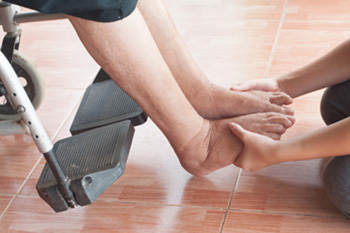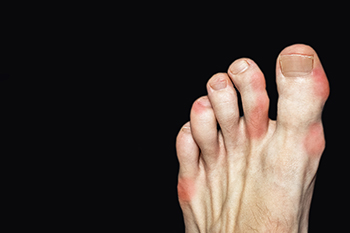Connect With Us
Blog
Items filtered by date: November 2023
Tailoring Exercises to Specific Foot Problems

Exercise, often synonymous with overall well being, plays a critical role in maintaining the health of our feet, especially when tailored to address specific concerns. For individuals grappling with flat feet, targeted exercises such as arch lifts and toe curls can help strengthen the arch and stabilize the foot. Those troubled by plantar fasciitis can benefit from gentle stretches to alleviate tension in the plantar fascia, promoting flexibility and reducing pain. For hammertoe, a common ailment, relief can be found through exercises like toe stretches and towel curls that enhance flexibility and strength. Similarly, conditions like bunions or arthritis benefit from low-impact exercises, such as swimming or cycling to maintain joint health. Tailoring exercise routines to address specific foot problems not only helps relieve symptoms but also contributes to overall foot health, promotes mobility and minimizes the impact of these conditions on your daily life. If you would like more information about what type of foot exercises and stretches to perform for your specific foot condition, it is strongly suggested that you visit a podiatrist who can provide you with the knowledge you are seeking.
Exercising your feet regularly with the proper foot wear is a great way to prevent injuries and build strength. If you have any concerns about your feet, contact Paul Hutchison, DPM from Hutchison Foot Clinic. Our doctor can provide the care you need to keep you pain-free and on your feet.
Exercise for Your Feet
Exercise for your feet can help you gain strength, mobility and flexibility in your feet. They say that strengthening your feet can be just as rewarding as strengthening another part of the body. Your feet are very important, and we often forget about them in our daily tasks. But it is because of our feet that are we able to get going and do what we need to. For those of us fortunate enough to not have any foot problems, it is an important gesture to take care of them to ensure good health in the long run.
Some foot health exercises can include ankle pumps, tip-toeing, toe rises, lifting off the floor doing reps and sets, and flexing the toes. It is best to speak with Our doctor to determine an appropriate regimen for your needs. Everyone’s needs and bodies are different, and the activities required to maintain strength in the feet vary from individual to individual.
Once you get into a routine of doing regular exercise, you may notice a difference in your feet and how strong they may become.
If you have any questions please feel free to contact our office located in Memphis, TN . We offer the newest diagnostic and treatment technologies for all your foot and ankle needs.
Elderly Foot and Ankle Problems

Foot and ankle problems are prevalent medical issues, particularly among the elderly, who often suffer from pain, stiffness, swelling, or deformities. Common diagnoses include conditions such as corns, athlete's foot, bunions, flat feet, ingrown nails, and warts. Aging-related muscle mass and loss of bone strength may increase seniors' risk for injuries and fractures, compounded by balance and vision issues. Key foot and ankle injuries in the elderly include ankle sprains, where the ligaments are overstretched or torn, potentially weakening the ankle and leading to arthritis, if untreated. Achilles tendonitis and tears are also common. The Achilles is vulnerable to inflammation and overuse, which can escalate to tears or ruptures, especially with sudden trauma. Ankle fractures are serious injuries from traumatic impact, requiring immediate podiatric attention to prevent complications such as infections. The spectrum of foot and ankle injuries in the elderly ranges from minor, treatable conditions to severe injuries necessitating medical intervention, highlighting the need for attentive care to prevent these issues. If you are elderly and have foot or ankle problems, it is suggested that you make an appointment with a podiatrist for a proper diagnosis and treatment.
Ankle pain can be caused by a number of problems and may be potentially serious. If you have ankle pain, consult with Paul Hutchison, DPM from Hutchison Foot Clinic. Our doctor will assess your condition and provide you with quality foot and ankle treatment.
Ankle pain is any condition that causes pain in the ankle. Due to the fact that the ankle consists of tendons, muscles, bones, and ligaments, ankle pain can come from a number of different conditions.
Causes
The most common causes of ankle pain include:
- Types of arthritis (rheumatoid, osteoarthritis, and gout)
- Ankle sprains
- Broken ankles
- Achilles tendonitis
- Achilles tendon rupture
- Stress fractures
- Bursitis
- Tarsal tunnel syndrome
- Plantar fasciitis
Symptoms
Symptoms of ankle injury vary based upon the condition. Pain may include general pain and discomfort, swelling, aching, redness, bruising, burning or stabbing sensations, and/or loss of sensation.
Diagnosis
Due to the wide variety of potential causes of ankle pain, podiatrists will utilize a number of different methods to properly diagnose ankle pain. This can include asking for personal and family medical histories and of any recent injuries. Further diagnosis may include sensation tests, a physical examination, and potentially x-rays or other imaging tests.
Treatment
Just as the range of causes varies widely, so do treatments. Some more common treatments are rest, ice packs, keeping pressure off the foot, orthotics and braces, medication for inflammation and pain, and surgery.
If you have any questions please feel free to contact our office located in Memphis, TN . We offer the newest diagnostic tools and technology to treat your foot and ankle needs.
Definition and Risk Factors of Gout

Gout is a form of arthritis characterized by sudden, severe attacks of pain, swelling, redness, and tenderness in the joints. It typically affects the joint at the base of the big toe, but other joints can also be involved. Gout is caused by the buildup of uric acid crystals in the affected joint, which leads to inflammation and excruciating pain. While gout can affect anyone, it predominantly targets men, especially those over the age of 30. Women become more susceptible after menopause. Individuals with a family history of gout are at a higher risk, as genetics can play a significant role. Lifestyle factors such as a diet rich in purine-containing foods that include red meat, seafood, and alcohol, may significantly contribute to developing gout. Additionally, obesity and high blood pressure also increase the likelihood of getting gout. Understanding the definition and risk factors of gout is vital for timely diagnosis and effective management. If you have gout, it is strongly suggested that you are under the care of a podiatrist who can help you to manage this condition, in addition to offering you effective prevention strategies.
Gout is a foot condition that requires certain treatment and care. If you are seeking treatment, contact Paul Hutchison, DPM from Hutchison Foot Clinic. Our doctor will treat your foot and ankle needs.
What Is Gout?
Gout is a type of arthritis caused by a buildup of uric acid in the bloodstream. It often develops in the foot, especially the big toe area, although it can manifest in other parts of the body as well. Gout can make walking and standing very painful and is especially common in diabetics and the obese.
People typically get gout because of a poor diet. Genetic predisposition is also a factor. The children of parents who have had gout frequently have a chance of developing it themselves.
Gout can easily be identified by redness and inflammation of the big toe and the surrounding areas of the foot. Other symptoms include extreme fatigue, joint pain, and running high fevers. Sometimes corticosteroid drugs can be prescribed to treat gout, but the best way to combat this disease is to get more exercise and eat a better diet.
If you have any questions please feel free to contact our office located in Memphis, TN . We offer the newest diagnostic and treatment technologies for all your foot and ankle needs.
Bearing Weight After a Broken Ankle

After one breaks an ankle, weight bearing restrictions can be imposed to facilitate proper healing. These restrictions encompass non weight bearing, where no weight can be placed on the leg. Toe touch weight bearing, which involves minimal toe contact with the ground can be effective for balancing. Partial weight bearing allows for a specific percentage of weight to be placed on the leg, and is generally managed by using crutches. Compliance with these restrictions is vital to promote the healing process. Disregarding them can lead to complications or delayed recovery. Signs of non compliance can include increased pain, swelling, or redness in the leg. If you have a broken ankle, it is suggested that you make an appointment with a podiatrist who can recommend the weight bearing protocols that will best help you.
Broken ankles need immediate treatment. If you are seeking treatment, contact Paul Hutchison, DPM from Hutchison Foot Clinic. Our doctor can provide the care you need to keep you pain-free and on your feet.
Broken Ankles
A broken ankle is experienced when a person fractures their tibia or fibula in the lower leg and ankle area. Both of these bones are attached at the bottom of the leg and combine to form what we know to be our ankle.
When a physician is referring to a break of the ankle, he or she is usually referring to a break in the area where the tibia and fibula are joined to create our ankle joint. Ankles are more prone to fractures because the ankle is an area that suffers a lot of pressure and stress. There are some obvious signs when a person experiences a fractured ankle, and the following symptoms may be present.
Symptoms of a Fractured Ankle
- Excessive pain when the area is touched or when any pressure is placed on the ankle
- Swelling around the area
- Bruising of the area
- Area appears to be deformed
If you suspect an ankle fracture, it is recommended to seek treatment as soon as possible. The sooner you have your podiatrist diagnose the fracture, the quicker you’ll be on the way towards recovery.
If you have any questions, please feel free to contact our office located in Memphis, TN . We offer the newest diagnostic and treatment technologies for all your foot care needs.
